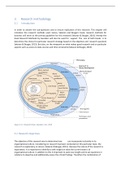3. Research methodology
3.1 Introduction
In order to answer the sub-questions and to ensure replication of this research. This chapter will
introduce the research methods used. Hence, Sekaran and Bougie’s book, research methods for
business will serve as the primary guideline for this research( Sekaran & Bougie, 2013). Hereby the
book Research Methods by Saunders will also be used for support. The aim of both books is to
determine the choice for particular research strategy based on the objective and research question(
Sekaran & Bougie, 2013). But also, on the viewpoint on what makes good research and on particular
aspects such as access to data sources and time constraints (Sekaran & Bougie, 2013).
Figure 3.1.1. Research Onion, Saunders et al., 2019
3.2 Research objectives
The objective of this research was to determine how can incorporate inclusivity in its
organizational culture. Considering no research has been conducted on this particular topic, the
research is exploratory in nature ( Sekaran & Bougie, 2013). Because the nature of the research is
exploratory. It is important to identify to seek insight on what the current state is of
organizational culture. In addition to this it important to seek new insight and to ask questions in
relations to objective and additionally assess the critical findings. Therefore the combination of
, literature review and interviewing experts within this field has been conducted. (Sekaran & Bougie,
2013). Due to this the research is taking the mixed method approach as the findings are expected be
both quantitative as well as qualitative.
3.3 Data collection method per sub-question
Generally, quantitative or qualitative approaches are considered for research depending on the aim
of the research (Sekaran & Bougie, 2013). The goal of the research in this content is to provide an
inclusion strategy that can implement in order to improve its organizational culture. More
specifically, the research examines how employees within all levels within the organization view
inclusion/ inclusion practices not only in headquarters in The Netherlands, but also Belgium and
France. The unconscious bias training, the yearly engagement survey and the organizational
restructuring has indicated that more attention needed to give to the organizational inclusivity and
the perceptions of inclusivity through all levels in the organization.
As to accomplish the overall research objective, the following methods were implemented for below
stated sub questions:
Sub-question 1: How are employees currently experiencing inclusion within in The Netherlands,
France, and Belgium?
3.3.1 Survey research
The survey research have been conducted in order to gather data about experience that employees
have regarding the organizational inclusivity as well as the assessing the level of inclusivity
incorporated. This has been done by collecting qualitative and quantitative data from the offices in
the Netherlands, Belgium and France. Additionally the target group that the survey is focused on are
the employees throughout the whole office. This includes departments such as Human resources, the
leadership team as well as the production, marketing department, and the works council. The reason
why the human resources department has been chosen is that the department has the most contact
with employees through the whole organization, due to this they have a broader view on the
organizational inclusion as well as the inclusion within the human resources department itself.
Furthermore, the leadership team named will also receive the survey as they are focused on the
organizations strategic level, by receiving their input a greater view can be set on which direction the
organizations wants to go regarding inclusion. The production and the marketing department are
the biggest departments within the office The Netherlands. Additionally these departments have
faced some challenges regarding co-collaboration and inclusion. Therefore, the sample size of the
survey research will be primarily from the production and marketing department.
The works council consist of a group of employees that provide support and guidance whenever
unethical situation happen to employees within the department, hereby discrimination, harassment
and racism comes into play. Therefore, it is imperative to send out the survey to this department in
order to measure the need of inclusion as well as measuring the occurrence of how many times the
employees are contacting the works council, this will indicate either the need of inclusion or the
stability of the organizational inclusion as of now.
The survey further consist of in total 24 questions, hereby the Funnelling technique has been
included. By using this technique general and easy closed questions have been generated and placed
at the beginning of the survey. The final survey questions can be viewed in appendix.
The survey starts with the identification of the employee based on the office location, nationality and
gender. After that 10 closed questions are formulated to indicate the way inclusion is experienced
by the employee. The survey then moves towards eleven scale questions, hereby the responds can
scale whether they agree or disagree with the given statements. The statements are formulated by





